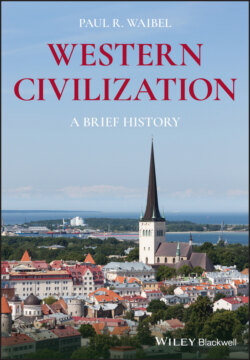Читать книгу Western Civilization - Paul R. Waibel - Страница 20
Minoan Civilization
ОглавлениеThe Bronze Age civilization centered on the island of Crete, that reached its height between approximately 1700 and 1450 BC, is known as “Minoan.” The designation is attributed to the English archeologist, Sir Arthur Evans (1851–1941), who began excavations on the site of Knossos in 1900. During the following three years, Evans unearthed the ruins of what appeared to have been a palace complex he described as “labyrinthine.” Like most well‐educated English gentlemen at the turn of the twentieth century, Evans was familiar with Greek mythology. The complex layout of the unearthed ruins, together with discoveries such as a double‐axe symbol found engraved on columns and depictions of individuals leaping over the backs of bulls, led Evans to associate the palace with the legend of King Minos of Crete, who kept a monster, part bull and part human, in a labyrinth.
Minoan Crete was the center of a vast trading empire that extended well beyond the Aegean Sea and the Greek mainland. They established trading posts in Syria and Egypt and other locations in the Near East and as far west as Sicily and Spain. The need for tin in the production of bronze connected Minoan Crete with such distant locations as Britain and Afghanistan, if only indirectly. Much like the tramp steamers of the nineteenth century that connected Europe with the world beyond its shores, the Minoans played a key role in the diffusion of the more advanced civilizations of Egypt and Southwest Asia to the emerging civilizations along the Mediterranean coast of Europe.
Much of what is known about Minoan life and culture has been deduced from the archeological evidence, rather than the written record. The Minoans were not Greeks, nor was their language Greek. What language they spoke remains unknown and unclassified. The earliest Minoan script is called “Cretan hieroglyphs” and has not been deciphered. A later script referred to as Linear A was in use between c. 1850 and c. 1400 BC. Like Cretan hieroglyphs, it has not been deciphered. A third script, Linear B, was first used in Knossos between c. 1450 and c. 1350 BC after the Mycenaean conquest of Crete. Its use spread from Crete to the Greek mainland. In 1953, Michael Ventris (1922–1956), an English architect and gifted linguist, broke the code. Ventris recognized that Linear B was the written script for an archaic form of Mycenaean Greek dialect.
Minoan settlements were scattered throughout the island of Crete. Whether or not there existed some sort of central authority, as some suggest, cannot be determined from the available archeological evidence. There were four major palace complexes, Knossos being the largest, which apparently exerted some sort of regional authority. The absence of any fortifications indicates that the Minoan civilization was a peaceful one. That assumption is reinforced by frescoes on the walls and in the floors of the palaces that depict tranquil scenes of daily life and nature. Women are portrayed in apparel with their breasts bare.
A small statuette approximately 13½ in. (342.9 mm) tall of a bare‐breasted woman holding a snake in each hand is thought to be evidence that Minoan religion revolved around worship of a mother goddess, perhaps the ancestor of the Greek goddess Artemis. A small ivory figurine called “the bull‐leaper,” a bronze sculpture of an individual leaping over the back of a bull, and wall frescoes of the same subject matter, all found at Knossos, are thought to depict the dangerous sport of bull leaping. Was it only a sport or a ritual involved in bull worship? Evidence of bull worship is found throughout the world.
Though the term Knossos is used today to refer to the Bronze Age archeological ruins, it was more than a palace complex. It is recognized as the oldest city in Europe. At its peak around in 1700 BC, as many as 100 000 people resided at Knossos. The palace covered six acres (2 ha) and included 1300 rooms connected by corridors. Some areas of the palace reached a height of five stories. Fresh water flowed to the palace and surrounding city in aqueducts. The water flowed through the palace in terracotta pipes. A separate closed system drained waste water and sewage to an outside sewer. What is thought to have been the queen's quarters included a water‐flushing system toilet and a bathtub.1
The Minoan civilization came to an end in the middle of the fifteenth century BC. The cause of its demise remains disputed. The mystery is heightened by attempts to associate Minoan Civilization with the legend of Atlantis. The intermingling of history with legends and mythology increases interest in ancient history, but also increases the difficulty in separating fact from fiction. Current consensus among scholars is that the eruption of a massive volcano 61 miles (100 km) north of Crete on the island of Santorini (Thera) sometime between 1627 BC and 1600 BC may have prepared the way for a subsequent conquest by the Mycenaean Greeks.
